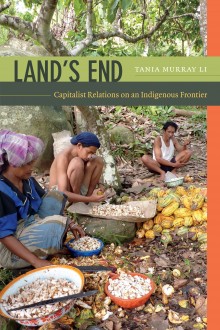What does a transition from subsistence agriculture to capitalist agriculture look like? At the January 23, 2015 book launch for Tania Li’s new book, Land’s End: Capitalist Relations on an Indigenous Frontier, co-sponsored by the Department of Anthropology, the Development Seminar Series, and the Asian Institute, Professor Li illustrated the ways in which one small community in Indonesia tackled this and other difficult questions in its transition to cocoa production.
Li’s book spans her research on the highland community of Sulaweisi, Indonesia, which began in 1995. Over twenty years, Li saw the community go from subsistence agriculture with shared land use to one where all means of production were dedicated to cocoa. The transition was motivated by periods of severe drought that the highlanders experienced, but took place subtly and without much acknowledgement over decades.
The book’s title refers to the end of land in several senses. Primarily, it is a reference to the end of food production and the transition to cash crops. However, it also signifies land’s new identity as a commodity, and along with that landless and landed classes of people. With this landless people comes a sense of unknown – there are no cities for the new class of landless to work in, and many families are thrown into abject poverty, which did not exist in the same way in subsistence farming.
An interesting concept raised by one of the discussants was the nature of capitalism itself. In her research, Li used a conceptualization of capitalism in which its primary manifestation is mandatory market participation. Li investigates the transition from a society without capitalist ownership to one dominated by it – sometimes in ways that we as Western capitalists may not think of. Throughout, Li stresses the compulsory nature of participation in the capitalist system. Initially, market participation was optional – highlanders could sell their food crops if they had any left over or their labor if they had a spare day or two. Under capitalism, in order to maintain any quality of life, one must utilize all of their available resources to sell in the market – either land or labor. Land plots are divided between family members and friends, sometimes through negotiation, but other times through force. Though the community initially aimed to maintain some semblance of balance between food production and cocoa production, eventually all land plots were dedicated to cocoa trees.
However, Li also emphasized the choice that the community of Sulaweisi made. Although there was not capitalist ownership in the same way before cocoa, there was a strong sense of ownership over one’s own labor. In that respect, Li posits that it was easier for the community to make a more subtle transition to capitalist ownership. Physical privatization took place alongside the transition to capitalism, but there were already conceptualizations of labor that were not collective.
Discussion of Li’s work was glowing, and the publication of this book is clearly the result of many years of careful research. The three discussants praised not only Li’s research, but also her ability to go beyond current trends in anthropological research and take a different approach – one driven more by statistics than narrative, unlike other current research. They also emphasized the scope that Li had taken with her work in taking a problem that took twenty years to develop and encapsulating it accurately and in great depth in her book.
-written by Rachel Ball-Jones, a second year student double majoring in political science and peace, conflict, and justice studies at the University of Toronto
This article is part of a series of articles written by undergraduate students affiliated with the Asian Institute about events hosted by the Asian Institute.
